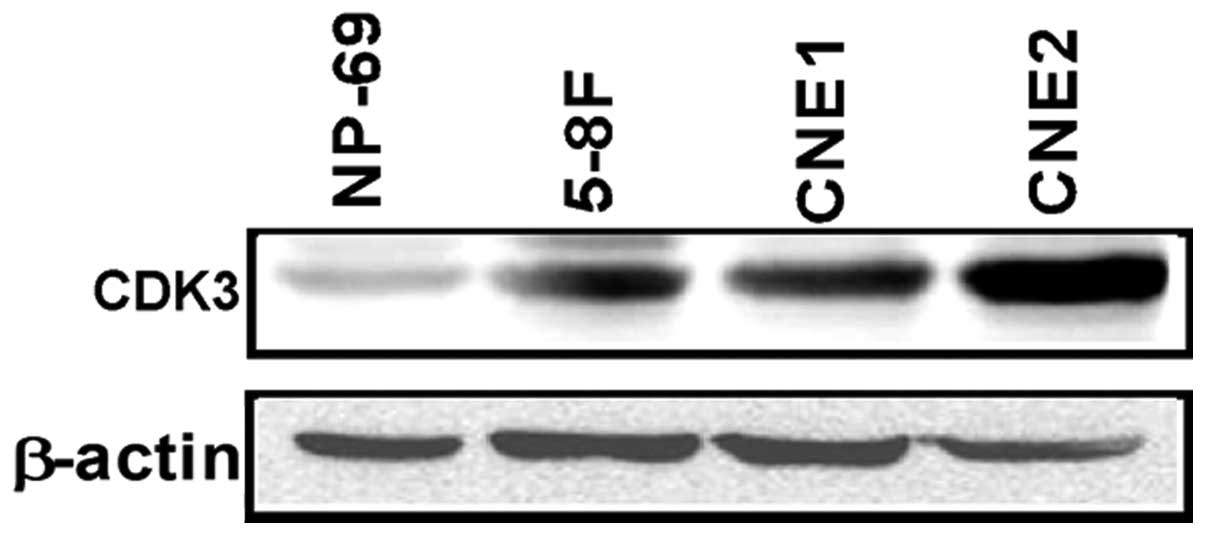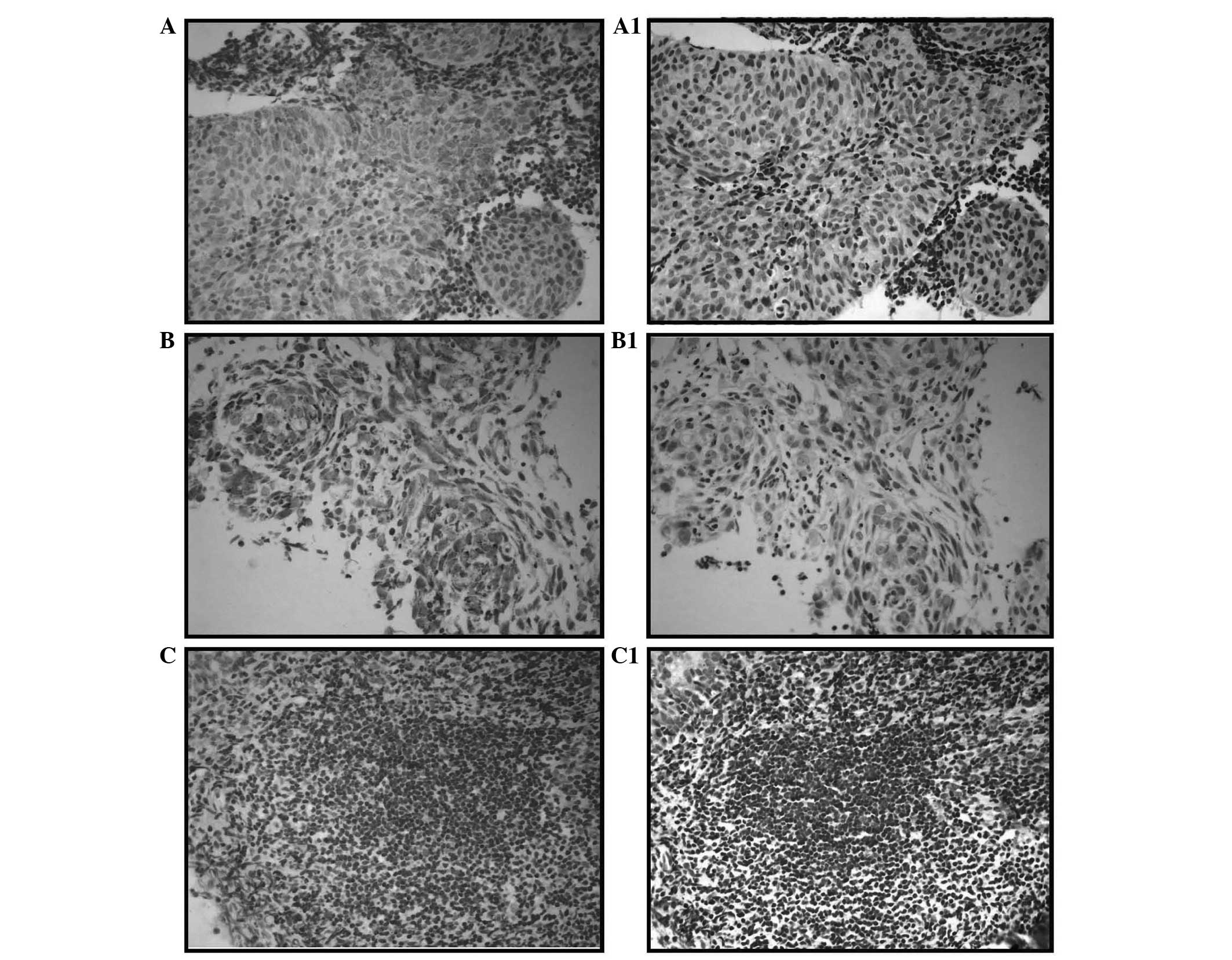|
1
|
Mutirangura A, Tanunyutthawongese C,
Pornthanakasem W, et al: Genomic alterations in nasopharyngeal
carcinoma: loss of heterozygosity and Epstein-Barr virus infection.
Br J Cancer. 76:770–776. 1997. View Article : Google Scholar : PubMed/NCBI
|
|
2
|
Wee JT, Ha TC, Loong SL and Qian CN: Is
nasopharyngeal cancer really a ‘Cantonese cancer’? Chin J Cancer.
29:517–526. 2010.
|
|
3
|
No authors listed. Cancer incidence in
five continents. VII. IARC Sci Publ; pp. i–xxxiv. pp. 1–1240.
1997
|
|
4
|
Chow E, Payne D, O’Sullivan B, et al:
Radiotherapy alone in patients with advanced nasopharyngeal cancer:
comparison with an intergroup study. Is combined modality treatment
really necessary? Radiother Oncol. 63:269–274. 2002. View Article : Google Scholar
|
|
5
|
al-Sarraf M and McLaughlin PW: Nasopharynx
carcinoma: choice of treatment. Int J Radiat Oncol Biol Phys.
33:761–763. 1995. View Article : Google Scholar : PubMed/NCBI
|
|
6
|
Chua DT, Sham JS and Au GK: A phase II
study of capecitabine in patients with recurrent and metastatic
nasopharyngeal carcinoma pretreated with platinum-based
chemotherapy. Oral Oncol. 39:361–366. 2003. View Article : Google Scholar
|
|
7
|
Meyerson M, Enders GH, Wu CL, et al: A
family of human cdc2-related protein kinases. EMBO J. 11:2909–2917.
1992.PubMed/NCBI
|
|
8
|
Miyata Y, Liu Y, Jankovic V, et al: Cyclin
C regulates human hematopoietic stem/progenitor cell quiescence.
Stem Cells. 28:308–317. 2010.PubMed/NCBI
|
|
9
|
Rao HV, Thirumangalakudi L and Grammas P:
Cyclin C and cyclin dependent kinases 1, 2 and 3 in
thrombin-induced neuronal cell cycle progression and apoptosis.
Neurosci Lett. 450:347–350. 2009. View Article : Google Scholar : PubMed/NCBI
|
|
10
|
Sage J, Miller AL, Pérez-Mancera PA,
Wysocki JM and Jacks T: Acute mutation of retinoblastoma gene
function is sufficient for cell cycle re-entry. Nature.
424:223–228. 2003. View Article : Google Scholar : PubMed/NCBI
|
|
11
|
Hofmann F and Livingston DM: Differential
effects of cdk2 and cdk3 on the control of pRb and E2F function
during G1 exit. Genes Dev. 10:851–861. 1996. View Article : Google Scholar : PubMed/NCBI
|
|
12
|
Ren S and Rollins BJ: Cyclin C/cdk3
promotes Rb-dependent G0 exit. Cell. 117:239–251. 2004. View Article : Google Scholar : PubMed/NCBI
|
|
13
|
van den Heuvel S and Harlow E: Distinct
roles for cyclin-dependent kinases in cell cycle control. Science.
262:2050–2054. 1993.PubMed/NCBI
|
|
14
|
Lee JY, Jeong W, Kim JH, et al: Distinct
expression pattern and post-transcriptional regulation of cell
cycle genes in the glandular epithelia of avian ovarian carcinomas.
PLoS One. 7:e515922012. View Article : Google Scholar
|
|
15
|
Zheng D, Cho YY, Lau AT, et al:
Cyclin-dependent kinase 3-mediated activating transcription factor
1 phosphorylation enhances cell transformation. Cancer Res.
68:7650–7660. 2008. View Article : Google Scholar
|
|
16
|
Cho YY, Tang F, Yao K, et al:
Cyclin-dependent kinase-3-mediated c-Jun phosphorylation at Ser63
and Ser73 enhances cell transformation. Cancer Res. 69:272–281.
2009. View Article : Google Scholar : PubMed/NCBI
|
|
17
|
Bullrich F, MacLachlan TK, Sang N, et al:
Chromosomal mapping of members of the cdc2 family of protein
kinases, cdk3, cdk6, PISSLRE, and PITALRE, and a cdk inhibitor,
p27Kip1, to regions involved in human cancer. Cancer Res.
55:1199–1205. 1995.PubMed/NCBI
|
|
18
|
Mao YP, Li WF, Chen L, et al: A clinical
verification of the Chinese 2008 staging system for nasopharyngeal
carcinoma. Ai Zheng. 28:1022–1028. 2009.(In Chinese).
|
|
19
|
Malumbres M and Barbacid M: Mammalian
cyclin-dependent kinases. Trends Biochem Sci. 30:630–641. 2005.
View Article : Google Scholar
|
|
20
|
Schang LM, Bantly A and Schaffer PA:
Explant-induced reactivation of herpes simplex virus occurs in
neurons expressing nuclear cdk2 and cdk4. J Virol. 76:7724–7735.
2002. View Article : Google Scholar : PubMed/NCBI
|
|
21
|
Keezer SM and Gilbert DM: Evidence for a
pre-restriction point Cdk3 activity. J Cell Biochem. 85:545–552.
2002. View Article : Google Scholar : PubMed/NCBI
|
|
22
|
Braun K, Hölzl G, Soucek T, Geisen C,
Möröy T and Hengstschläger M: Investigation of the cell cycle
regulation of cdk3-associated kinase activity and the role of cdk3
in proliferation and transformation. Oncogene. 17:2259–2269. 1998.
View Article : Google Scholar : PubMed/NCBI
|
|
23
|
Alessandrini A, Chiaur DS and Pagano M:
Regulation of the cyclin-dependent kinase inhibitor p27 by
degradation and phosphorylation. Leukemia. 11:342–345. 1997.
View Article : Google Scholar : PubMed/NCBI
|
|
24
|
Baba Y, Tsukuda M, Mochimatsu I, et al:
Reduced expression of p16 and p27 proteins in nasopharyngeal
carcinoma. Cancer Detect Prev. 25:414–419. 2001.PubMed/NCBI
|
|
25
|
Pan Y, Zhang Q, Tian L, et al: Jab1/CSN5
negatively regulates p27 and plays a role in the pathogenesis of
nasopharyngeal carcinoma. Cancer Res. 72:1890–1900. 2012.
View Article : Google Scholar : PubMed/NCBI
|
|
26
|
Shih LC, Tsai CW, Tsai MH, et al:
Association of cyclin D1 genotypes with nasopharyngeal carcinoma
risk. Anticancer Res. 32:1093–1098. 2012.PubMed/NCBI
|
|
27
|
Acikalin MF, Etiz D, Gurbuz MK, Ozudogru
E, Canaz F and Colak E: Prognostic significance of galectin-3 and
cyclin D1 expression in undifferentiated nasopharyngeal carcinoma.
Med Oncol. 29:742–749. 2012. View Article : Google Scholar
|
|
28
|
Hung MC and Link W: Protein localization
in disease and therapy. J Cell Sci. 124:3381–3392. 2011. View Article : Google Scholar : PubMed/NCBI
|
|
29
|
Shapiro GI: Cyclin-dependent kinase
pathways as targets for cancer treatment. J Clin Oncol.
24:1770–1783. 2006. View Article : Google Scholar : PubMed/NCBI
|
|
30
|
Yang ES and Burnstein KL: Vitamin D
inhibits G1 to S progression in LNCaP prostate cancer cells through
p27Kip1 stabilization and Cdk2 mislocalization to the cytoplasm. J
Biol Chem. 278:46862–46868. 2003. View Article : Google Scholar : PubMed/NCBI
|
|
31
|
Flores O, Wang Z, Knudsen KE and Burnstein
KL: Nuclear targeting of cyclin-dependent kinase 2 reveals
essential roles of cyclin-dependent kinase 2 localization and
cyclin E in vitamin D-mediated growth inhibition. Endocrinology.
151:896–908. 2010. View Article : Google Scholar
|
|
32
|
Bryja V, Pacherník J, Vondrácek J, et al:
Lineage specific composition of cyclin D-CDK4/CDK6-p27 complexes
reveals distinct functions of CDK4, CDK6 and individual D-type
cyclins in differentiating cells of embryonic origin. Cell Prolif.
41:875–893. 2008. View Article : Google Scholar
|












